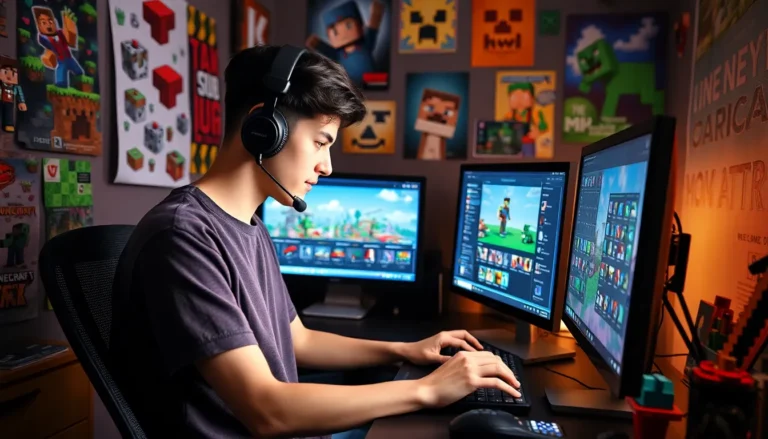In a world where screens dominate daily life, blue light has become the unwelcome guest at the digital party. It sneaks into our lives through smartphones, laptops, and TVs, leaving us squinting and sleep-deprived. But fear not—blue light blocking tech is here to save the day, or at least our eyes.
Imagine a life where you can scroll through social media without feeling like you’ve stared into the sun. With innovative solutions like blue light glasses and screen filters, protecting those precious peepers has never been easier or more stylish. So, why not embrace the tech that keeps your eyes happy and your sleep restful? After all, who wouldn’t want to binge-watch their favorite shows without the dreaded eye strain?
Table of Contents
ToggleOverview of Blue Light Blocking Tech
Blue light blocking technology consists of products designed to reduce exposure to blue light emitted by electronic devices. Glasses specifically designed for this purpose often feature special coatings that filter out harmful blue light wavelengths. Users experience less eye strain and discomfort with these glasses during prolonged screen time.
Screen filters also play a crucial role in blocking blue light. These attach directly to devices and protect users from glare while softening the harshness of bright screens. Many people find that using filters improves their comfort level during extended periods of use.
Software applications that adjust screen color temperature can enhance the effectiveness of blue light blocking tech. These programs change display colors to warmer tones, especially during evening hours. Users may find that their sleep quality improves when using these applications alongside physical blockers.
Adopting blue light blocking tools can also benefit individuals who work late or use devices before bedtime. Research indicates that reducing blue light exposure before sleep supports better rest. This is particularly relevant in today’s digital age where many rely on technology throughout the day and evening.
The market offers a variety of options for blue light blocking glasses and screen filters. Each product varies in design, style, and effectiveness. It’s essential to choose high-quality items from reputable brands to ensure that users receive adequate protection.
Benefits of Blue Light Blocking Tech
Blue light blocking technology offers significant advantages for individuals frequently engaging with screens. These benefits include improved sleep quality and reduced eye strain.
Improved Sleep Quality
Blue light exposure, especially at night, disrupts circadian rhythms and hinders sleep quality. Blocking blue light with specialized lenses or screen filters creates a healthier sleep environment. Reduced exposure promotes the body’s natural production of melatonin, enhancing overall sleep patterns. Users adopting these tools report falling asleep faster. Studies indicate that individuals using blue light blockers before bed experience deeper sleep cycles. Embracing this technology can lead to better rest for those who rely on electronic devices into the evening.
Reduced Eye Strain
Eye strain frequently occurs during prolonged screen time due to blue light emissions. Blue light blocking lenses filter out harmful wavelengths, alleviating discomfort. Many users note a significant reduction in symptoms like headaches and blurred vision after using these products. Along with relief, decreased glare enhances visual clarity, contributing to more comfortable device usage. Adopting blue light filtering software can complement physical blockers, optimizing screen experiences. They work together to provide a more enjoyable viewing experience, proving valuable for both professional and recreational users.
Types of Blue Light Blocking Tech
Various types of blue light blocking technology help reduce eye strain and improve sleep quality. Users can choose from screen protectors, glasses, and software solutions.
Screen Protectors
Screen protectors effectively reduce blue light exposure by filtering harmful wavelengths. They attach directly to devices like smartphones, tablets, and computers. Different brands offer varying levels of protection, so opting for a high-quality protector is essential. Multiple types include adhesive films and tempered glass protectors, each providing unique levels of clarity and durability. Users report experiencing less glare and improved visual comfort when using these products.
Glasses
Blue light blocking glasses feature specialized coatings that filter blue light emitted from screens. Various styles cater to different preferences, from fashionable frames to more functional designs. Users can select prescription lenses or non-prescription options based on their needs. Many glasses also reduce glare and enhance visual contrast, making screen time more comfortable. Reviews often highlight the immediate relief users experience after wearing these glasses during extended use.
Software Solutions
Software solutions adjust screen color temperature to minimize blue light exposure. Programs vary from simple filters to comprehensive applications that adapt based on time of day. Users benefit from features that reduce brightness and shift colors to warmer tones, enhancing visual comfort. Many operating systems now include built-in options, while dedicated applications offer additional customization. Utilizing these solutions alongside physical blockers creates an optimal viewing experience.
Potential Drawbacks of Blue Light Blocking Tech
While blue light blocking technology offers numerous benefits, some potential drawbacks exist. Understanding these limitations helps users make informed decisions regarding their digital engagement.
Efficacy Concerns
Efficacy concerns often arise regarding the effectiveness of blue light blocking solutions. Research indicates that the degree of blue light reduction varies between products. Not all glasses filter the same wavelengths, questioning whether some users experience actual relief. Additionally, anecdotal evidence suggests mixed results; some individuals may notice significant improvements, while others feel little difference. Relying solely on blue light blockers might not address underlying issues like improper ergonomics or prolonged screen time. Consulting eye care professionals can provide tailored advice for individual needs.
Dependency on Technology
Dependency on technology poses another potential drawback of blue light blocking solutions. Users might become reliant on these products for comfort without addressing root causes of eye strain. Continuous screen use itself can lead to more significant eye issues, even when using protective tech. Developing healthy screen habits, such as regular breaks and adjusting brightness, remains essential. Focusing on a balanced approach ensures that technology complements rather than replaces good practices for eye health. Awareness of this dependency encourages proactive behavior rather than passive reliance.
Conclusion
Embracing blue light blocking technology can significantly enhance daily screen interactions. By reducing eye strain and improving sleep quality, these tools offer practical solutions for anyone spending extended hours in front of digital devices.
With various options available such as glasses, screen filters, and software applications, users can find the right fit for their lifestyle and needs. However, it’s essential to combine these innovations with healthy screen habits to achieve optimal eye health.
As awareness of blue light’s effects grows, investing in high-quality products becomes crucial. Prioritizing eye comfort and well-being will lead to a more enjoyable and productive digital experience.




